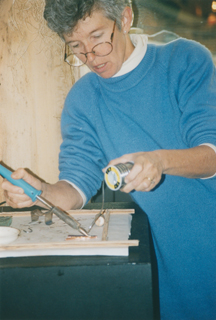 |
 |
|
|
 |
I love the richness of the color that
flows from a piece of stained glass when the sunlight hits
it just right. This is the best reason I can think of for
creating these pieces.
My work uses three-dimensional glass that is cracked or
broken and no longer usable as such, for instance vases,
pitchers, or ornaments. These are woven into the work
alongside the flat colored (“stained”) glass one buys at
craft shops. Adding shells, pieces of wood and stones
completes the effect of a collage.
Here I am, on a freezing winter day,
digging through snow and ice to find glass treasures. A
glass-blowing firm nearby had cleaned its attic of broken
glass pieces, and a friend had called me to tell me the
dumpsters were full.
As I was teaching a friend the art of
stained glass, she counted seventeen steps involved in the
making of a glass piece, including: designing, choosing
the glass and other objects to be used, marking the
pattern, cutting, grinding, foiling (using a thin strip of
copper foil, sticky on one side in order to adhere to the
sides of the glass), fluxing to rid the area of dirt,
soldering (solder is an alloy of lead and tin which
interacts with copper to create a ridge of metal between
the pieces of glass), washing and finally, polishing.
These steps are the bones of the work. As you can see, it
takes a long time and a lot of elbow grease. The results
are wonderful.
 |
 |
| (Close-up shot
showing the solder line) |
( soldering) |
|
|
 |
 |

|
 |
|
|
Copyright © 2012 Beardsley
|
|
|
 |
 |

